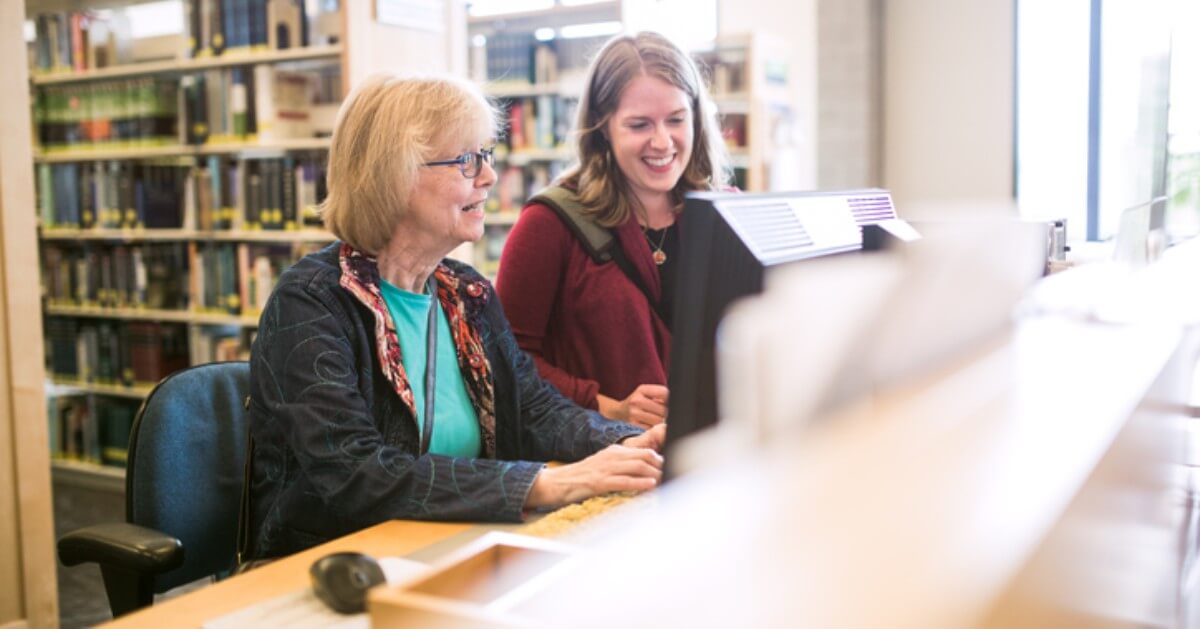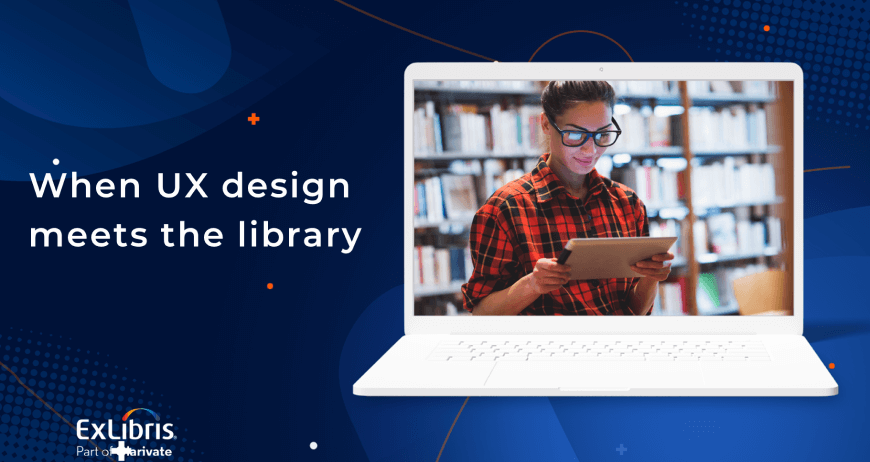How to create a great user experience that makes patrons and staff more productive (and happier)
Library patrons and staff have differing abilities, goals and environments when using online research services, systems and learning resources. How do digital product designers balance these differing needs to ensure students, faculty, librarians and researchers can all accomplish what they set out to do?
Designed for use or for users?
Everything man-made is designed – poorly or well — from a chair to a building, from a mobile phone to a crossroads, and everything in between.
Steve Jobs once said, “Design is not just what it looks like and feels like. Design is how it works.”
If so, then user experience (UX) design is how it works when we actually use it. It is the fit between a product and a user’s capabilities, environment and goals.
Imagine a left-handed person using right-handed scissors or a hairdresser using a paramedic’s trauma shears. They are indeed using an implement that works as designed, but the experience is very different than it should be.
What is true for physical objects applies all the more so to the digital world. A laptop, a smartphone, a website, an app, self-checkout at the supermarket, and many other systems we use are highly complex and often simultaneously serve multiple users.
Who is in the library and why?
Library services and library management systems and solutions are used by a lot of different people, with many different goals in mind. This includes, of course, librarians, but also researchers, instructors and students.
For example, a first-year university student is likely to search a library’s collection for a specific article or resource needed for a class they are taking. A researcher, on the other hand, may be exploring interesting directions in their field and searching for articles on a topic they know very well. In addition, it could be the first time the student has ever been exposed to an academic database, while the researcher understands exactly how it works. The researcher is intimately familiar with the academic world, knows what they are looking for, and can make full use of the results they get. For them, searching for a resource requires much less effort than for the student.
Moreover, the same individual may wear different “hats” at different times. A researcher is often also an instructor, and librarians generally have multiple roles in the academic ecosystem. In each case, their journey through the library’s digital systems is for a different purpose and includes distinct workflows.
The digital environment also plays an important role. Instructors and students often start their online day in a learning management system, which presents them with what they need in a specific course. For example, Leganto, the Ex Libris course material reading list management system, is just one element of many in that environment. Instructors may access it once a semester to build a reading list, while students might use Leganto many times for multiple courses, with different instructors who organize their reading lists in their own way.
Librarians, on the other hand, see Leganto from a completely different perspective. They may be using Leganto multiple times a month to provide and update resources or otherwise assist in ensuring course material is available and accessible for all university courses. Their capabilities and familiarity with the solution are naturally very different than those of students and faculty.
The time, place, goals, needs and pain points of typical user scenarios all need to be taken into account when building library systems, apps or features. Accomplishing that is at the heart of user experience design.
UX Design: Behind the scenes
How can we address the UX challenges we have discussed thus far and design the best product or feature for our users? Let’s take a look behind the scenes at the process we use at Ex Libris as a library software.
Discovery
The first step in UX design is listening. We need to look at the world through the user’s eyes, and learn about their tasks, workflows, motivations and problems. At this stage, the goal is discovering what we don’t know.
We recruit participants for a qualitative user study from among members of the current Ex Libris user community. The initial individual interviews with likely users include many high-level, open-ended questions (e.g., describe a typical day; how do you accomplish a specific task, etc.), intended to provide an overview of the expected workflows and the typical users. One precaution to take when writing the questions is to make sure they are broad enough to cover various users and scenarios, but still targeted enough to elicit the information you need.
The interviews help us build complex personas, a UX tool for representing categories or types of users as named avatars. Such identifiable personas create empathy, which is very important for effective UX design. Alongside insights into user goals, frustrations, tasks, preferred devices and familiarity with the system, the interviews provide an understanding of the mental model users have of their workflows, as well as their pain and delight points. Of course, different users have different workflows, and an individual user might even take different paths each time they log in.
We can then get a full picture of the user journey. Each step of the workflow can be correlated with information from the interviews, in order to track persona mindset and emotions. It becomes possible to see where along the way they experience smooth sailing and where the experience becomes harder or more frustrating.
Once the UX team identifies a specific area to address, it is time to bring in a user focus group. Participants, drawn from various relevant backgrounds and organizations, meet on a regular basis to jointly discuss topics presented by an Ex Libris representative. These highly informative interactions provide the UX team relatively quickly with a deeper understanding of critical design issues and goals.
Another great source of feedback from users on what’s bothering them and what can be improved is the Ex Libris Idea Exchange. On this platform, users can suggest product improvements and vote on other users’ ideas. The comments and suggestions are reviewed by UX designers and can spark the introduction of new features.
Design
Moving from the discovery phase to designing a solution, the UX team considers how each feature would be used by relevant personas and how it would affect them. Such considerations guide changes, refinements and prioritization of planned designs. For example, if a mobile-first persona emerges, then UX designers would primarily focus on the mobile interfaces and then add a desktop. Similarly, designs intended for a persona – nicknamed, say, “Occasional Oliver” – who rarely uses the system could be designed with more ‘step by step’ workflows with simplified functionality.
Using specialized tools, the UX design team then builds a prototype. It simulates their vision of the final product, demonstrating its look and behavior, without actually developing it fully.
Usability sessions
The most valuable purpose the prototype serves is as a working interface for usability sessions with likely users. They are asked to mimic their normal interaction with the prototype in response to assigned tasks or imaginary scenarios. A critically important aspect of this exercise is getting users to talk us through what they are doing, thinking and expecting to happen at each step along the way. (We might prompt them with questions like: What do you expect to happen next? What do you understand from this screen? Is there anything missing here?)
It is important to note that we are not testing the users, we’re testing the interface. The goal is to know what works and what does not. For example, customers using the Ex Libris research discovery solutions – Summon expressed appreciation for the ability to bookmark search results; yet, in practice, we noted that the feature was rarely being used. During usability sessions after a redesign, we discovered why – many users simply did not recognize the bookmarking icon for what it was. After changing the icon in response to the usability session feedback, there was a dramatic jump in the use of the bookmarking feature.
Another great way to get direct feedback on design issues is using Basecamp. We open discussion boards focused on specific topics on the popular project management and team communication platform. We invite users to the board and ask for their opinion on various design elements or entire projects. Very quickly, we get a lot of comments about what makes sense and what doesn’t from a user perspective. As part of the discussion, we can even share a few options for design changes and hear from our customers which they think is best.
In one interesting example of collaboration with our community of users, we used Basecamp to help design an entirely new platform from scratch. The team that built Esploro, Ex Libris’ research information management solution, invited all potential customers to a Basecamp forum and, for eight months, shared designs for various aspects of the product with the would-be users. They received feedback very quickly, took it back to the drawing board, created another solution if needed, which they then brought back to the Basecamp forum for another round of feedback, and so on, in an iterative process that eventually produced the final Esploro product. Thanks to the creative exchange that produced it, Esploro began its life in perfect sync with actual user needs.
Early adopters
With the feedback received from the usability sessions and Basecamp, a fully functional product can be developed. However, we are not quite done yet with refining the product’s UX design. The first release is limited to a select group of early adopters, generally customers with whom we have a close working relationship. They are given access to a sandbox environment, where they can use the actual product even while our UX team is still working on certain aspects of the design. These early adopters tend to provide a lot of useful feedback, including what steps don’t make sense to them, what events they didn’t expect, how user-friendly individual buttons are, and more.
Release: It works!
Finally, the product or feature is tweaked as much as possible and released into the wider market. But that does not mean the UX design team is done. In fact, we begin collecting user feedback immediately after each release.
We see the real-world outcome of our UX design work and, in an iterative process, essentially repeatedly return to the discovery phase. This includes tracking metrics for use of the newly released product or feature and circling back to the Ex Libris Idea Exchange platform to learn how it is being used in practice.
The ongoing feedback loop also helps to reduce visual overload, which can happen when more and more features are released over time. It is sometimes difficult for behind-the-scenes teams to gain that perspective without actual user input after release, which then becomes an excellent opportunity to consider streamlining and cleaning up the interface in a follow-up redesign.
A holistic approach
Ideally, like at Ex Libris, UX design should be integrated and consistent across all related products. Aside from providing users a predictable and positive experience, such coherence also helps UX designers. They can leverage input from colleagues working on other products and collaborate to provide the best overall solution for their customers.
At the same time, it is imperative to bear in mind that there is no one fix for all. We must listen carefully to all our customers, understanding that there are many different kinds of users in the library industry, with many different needs.
The steps we laid out in this white paper may take a lot of resources and time, but the insights gained into user needs, wants and capabilities are extremely valuable for effective UX design. The role of UX designers is, ultimately, to provide the best possible product, to help each user accomplish their tasks in the best possible way, and to provide them with the best possible experience while they’re doing so.
For more on the topic of this blog, read here the full “When UX Design meets the Library” white paper.










